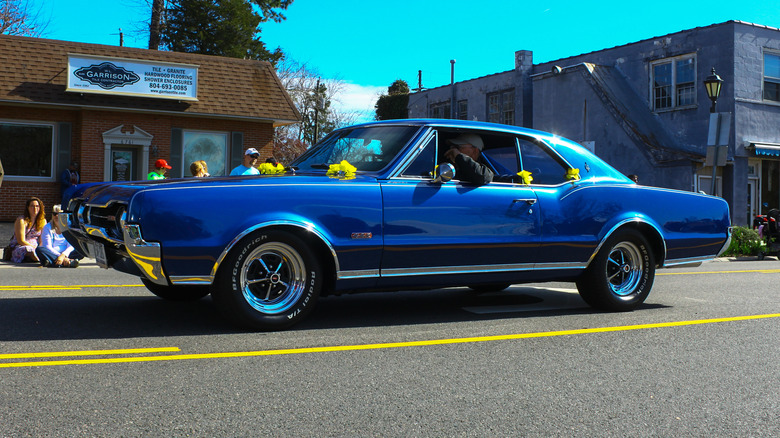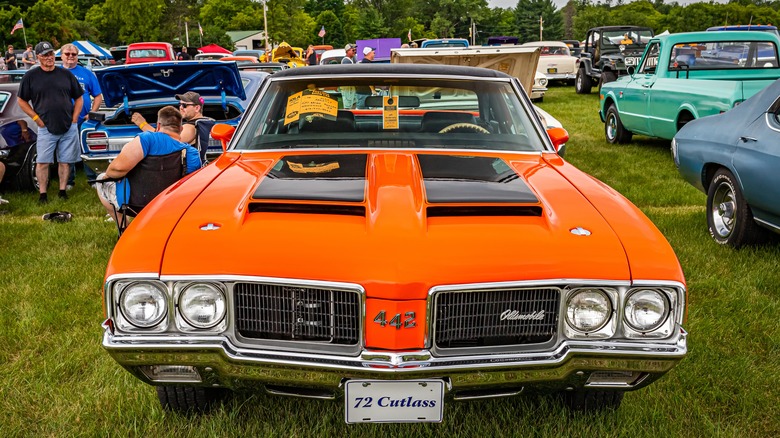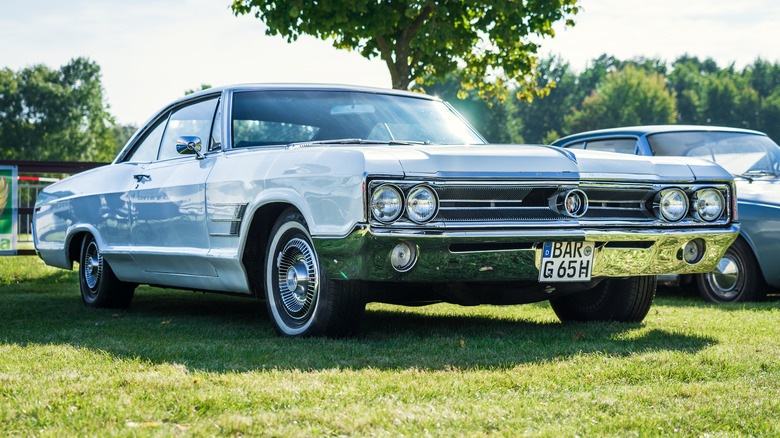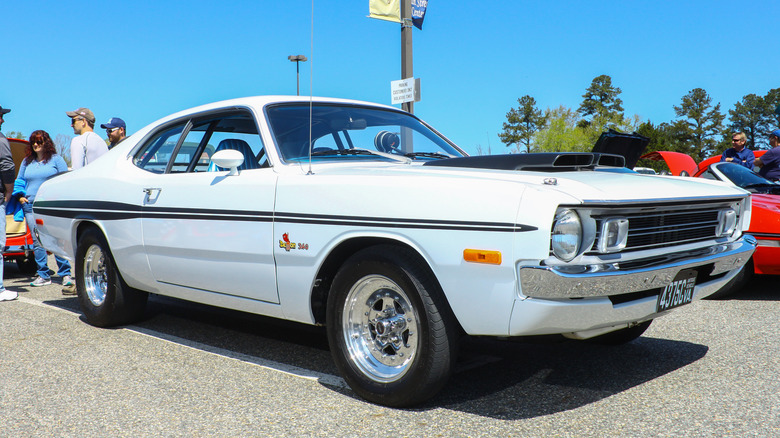5 Of The Most Underrated Muscle Cars Ever Made
Some of the most iconic vehicles ever manufactured fall into the muscle car category. The Ford Mustang needs no introduction, the Dodge Charger is a worthy rival, and the Chevrolet Chevelle is yet another icon. Muscle cars look strong, and have the power to back those looks up.
Under the hood, you'll often find a V8 large enough to pull a truck purring away. It's not just power and looks that make muscle cars stand out, they've made an impact on the big screen too. "The Dukes of Hazzard," "Starsky and Hutch," "The Bandit," "Frank Bullitt," and "Jack Reacher" have all spent time behind the wheel of a muscle car.
Not all muscle cars get the same level of exposure. Some incredibly beautiful, powerful vehicles have flown completely under the radar. This is both a tragedy and an opportunity, as these underrated beasts can often be a cheap way to get a muscle car on your driveway. Here are five classic muscle cars that deserve a lot more love than they currently get.
Oldsmobile Cutlass 442
The Oldsmobile division of General Motors is long gone, so you aren't going to get an electric successor to the 442 like we've seen with the Mustang, and are about to see with the Dodge Charger and Challenger. There's also the fact that the 442 doesn't have the same iconic status as Ford and Dodge's flagship muscle cars — which can hinder the chances of a revival.
That is a real shame, as the Oldsmobile Cutlass 442 has all of the ingredients a truly iconic muscle car needs. The name is derived from the vehicle's components: In its original configuration, the carburetor had four barrels, the transmission had four gears, and the exhaust gases escaped through a dual exhaust system.
All of this went out of the window, along with everything else that made the 442 cool, in the 1990s. The vehicle then died a slow, sad death that probably tarnished a few people's memories of it. Early examples had everything that made a 1960s muscle car great, and at its peak, it was being pulled around by a 400-cubic-inch V8.
You can find a classic 442 in great condition for as little as $20,000 — which is around what some rusted-out shells of certain former Mustangs cost. In short, the 442 is a great choice if you're looking for an affordable, entry-level classic muscle car.
Mercury Cyclone Spoiler
If you're looking for something truly unique, consider the Mercury Cyclone Spoiler. Much of Mercury's output in the muscle car era was similar to its parent company Ford — but the Cyclone Spoiler was truly a standout piece.
The Cyclone Spoiler was a thing of beauty. The crosshair in the center of the front grille is a standout feature, and it looks more futuristic than the car has any right to. The front end was shaped like a recurve bow, which was very unique and intimidating if you found yourself locked in a staring contest with the Cyclone's headlights.
The tail lights were equally stunning, again featuring crosshairs. In retrospect, it's possible that it eerily foreshadowed some cyberpunk elements that would regularly appear in sci-fi movies around a decade on from the Cyclone Spoiler's initial release.
In between it all, there is a powerful and classically shaped muscle car. Powering this beast is a V8 Cobra engine with 429 cubic inches of displacement. The engine is capable of 379 horsepower, which is still pretty good these days, but was definitely something to shout about over 50 years ago.
There was also a drag pack that would improve performance and ekes out an extra five horsepower for an extra fee. Chuck in things like a scoop on the hood, and a rear spoiler, then you have a truly great muscle car from the vehicle class' golden era.
Buick Wildcat
The Buick Wildcat existed from the earlier days of the muscle car era, right up to the vehicle class' golden age — from 1962 until 1970. If you look at one of the earlier models, it is closer to the long and low vehicles of the 1950s in terms of looks. But by the mid-'60s, the Wildcat had adopted the form of a classic muscle car, with the likes of the Wildcat Sport Coupe.
The Wildcat's engine has also got its own unique claim to fame. The 400 horsepower engines also found their way into the AG-330 Start Cart — the vehicle responsible for getting the infamous SR-71 Blackbird going. While they may not have powered the iconic supersonic bomber themselves, the Blackbird's lack of in-built starters means it wouldn't be moving anywhere without the same thing that gets a Wildcat off the line.
Despite being underrated, the Wildcat might soon be making a comeback — or its name could, at least. GM unveiled a "Buick Wildcat" concept EV last summer, and plans to go all-electric by the end of the decade. Despite the concept turning heads, there are currently no plans to put the "Wildcat" EV into production.
Pontiac 2+2
The genesis of the muscle car is a hotly contested topic. Gearheads have pointed towards muscle car-like traits in vehicles that were produced as early as the late 1940s. However, one of the more popular picks for first proper muscle car is a Pontiac — the 1964 GTO to be exact. Because of this, early GTOs are highly collectable, but it's possible to get something very similar for not much money at all.
Pontiac's 2+2 came out the same year as the GTO, and started out as a modified Catalina. However, from 1965 onwards, it was essentially a larger and more powerful version of the popular early muscle car. The 2+2 was only produced until 1967 and don't crop up too often, but if you find one, you might be able to snag an absolute bargain. According to Hagerty, a good condition 2+2 can be had for under $30,000, but performance and price isn't the only reason you should try to grab this classic. It ticks all of the muscle car boxes, while still offering something unique.
The later models, with their bowtie-like grille and headlight configuration, stand out more than others. If you park up with one of these, people will come up to you and talk to you about it. What's the point in owning a classic if you can't talk about a painful carburetor rebuild with random men in the street three times a week?
Dodge Dart Demon
When it comes to Dodge's muscle cars, most people are going to rattle on about the Challenger or Charger. The Charger was the ride of choice for Bo and Luke Duke, and also served as the vehicular antagonist to Steve McQueen's 1968 Ford Mustang in "Bullitt." The Challenger is also no stranger to the silver screen, cropping up in the likes of "Vanishing Point," "The Gumball Rally," and "Death Proof."
The Dodge Dart hasn't received as much exposure, but is no less deserving of love. The Dodge Dart Demon, in particular, is an incredibly worthy muscle car — with the 1971 edition packing a 275 horsepower V-8 and a three-speed manual gearbox. The Dart, and all of its offshoots, were part of a range of small cars Dodge began pumping out in the early 70s.
This leads to another debate, centered around if "pony cars" like the Dart are, in fact, true muscle cars. A few decades ago, this would have been a valid argument. However, modern muscle cars tend to be more compact and come with shorter wheelbases. If you write off the Dart because of its small stature, you're going to have to write off an obscene number of Mustangs with it.



